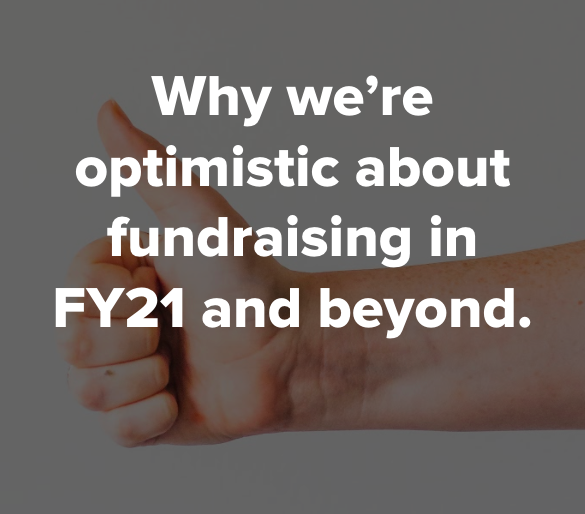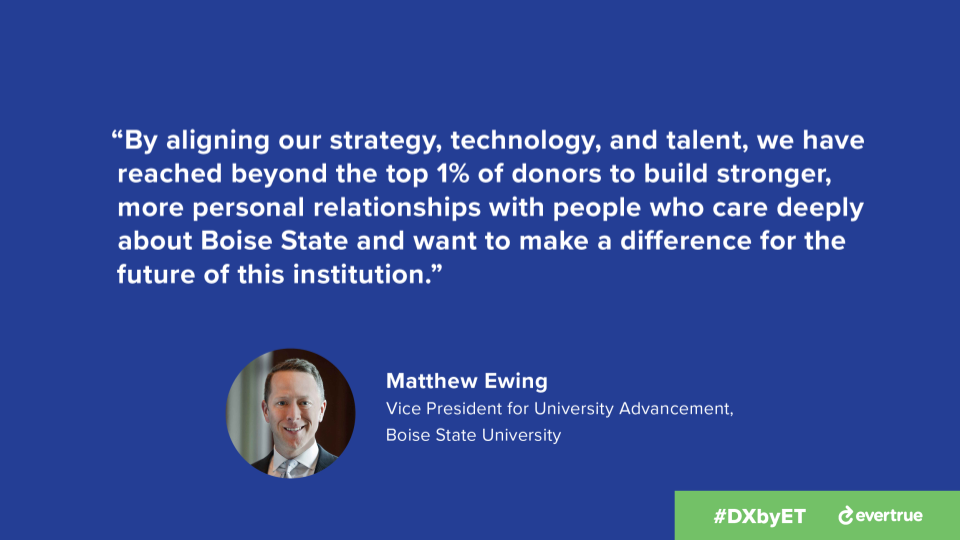We analyzed data from our fundraising partners and trends in consumer behavior. We’re bullish on the fundraising outlook for the rest of 2021 and FY22 — but only if organizations choose to embrace new opportunities and accept that the COVID-19 pandemic has changed fundraising forever.
Brent Grinna, EverTrue’s founder and CEO, first presented these data and projections in a (fantastic) webinar. Watch the recording here.
Watch the full webinar recording or continue reading for the full breakdown.
Every compilation of giving trends, participation, and revenue comes from an analysis of EverTrue’s educational fundraising customers unless otherwise specified.
2020 delivered unprecedented challenges
A global pandemic. The explosion of remote work. A presidential election. A long-overdue national reckoning on social injustice. Record unemployment. Record highs (and lows) in the stock market.
Any one of these events would have disrupted regularly scheduled programming for fundraising and alumni engagement. Together, they flipped our entire world upside down.
As COVID-19 shut down daily life in the United States beginning in early March of 2020, many teams pulled back on fundraising — shutting down giving days, pulling gift officers off the road, and halting appeals.
During the first months of the pandemic (March-May 2020), donor counts plummeted.
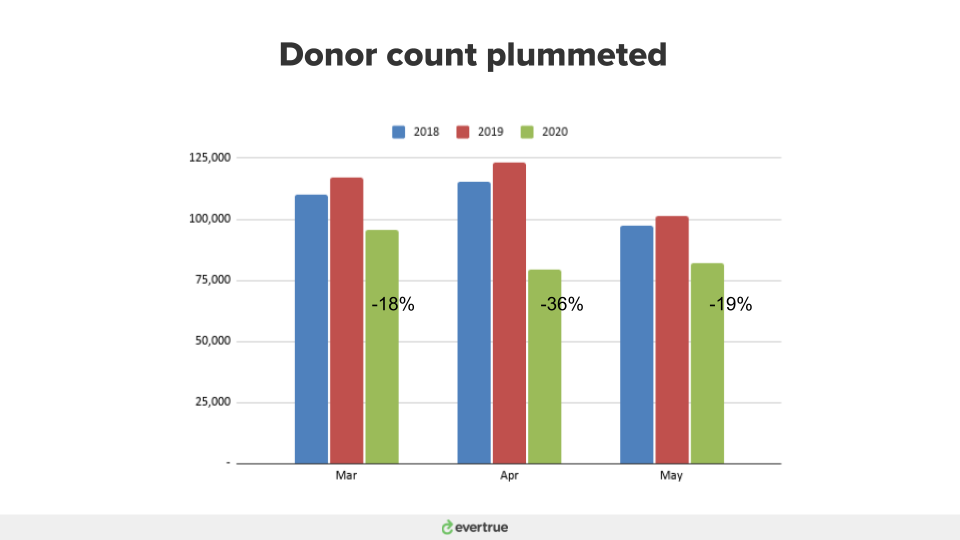
Advancement teams saw a 24.67% year of decline in donors in the March-May timeframe.
Excluding revenue from gifts greater than $1 million (which can fluctuate based on a handful of mega-sized gifts), year-over-year donor revenue dropped 25% during the same time period before it started to climb back.
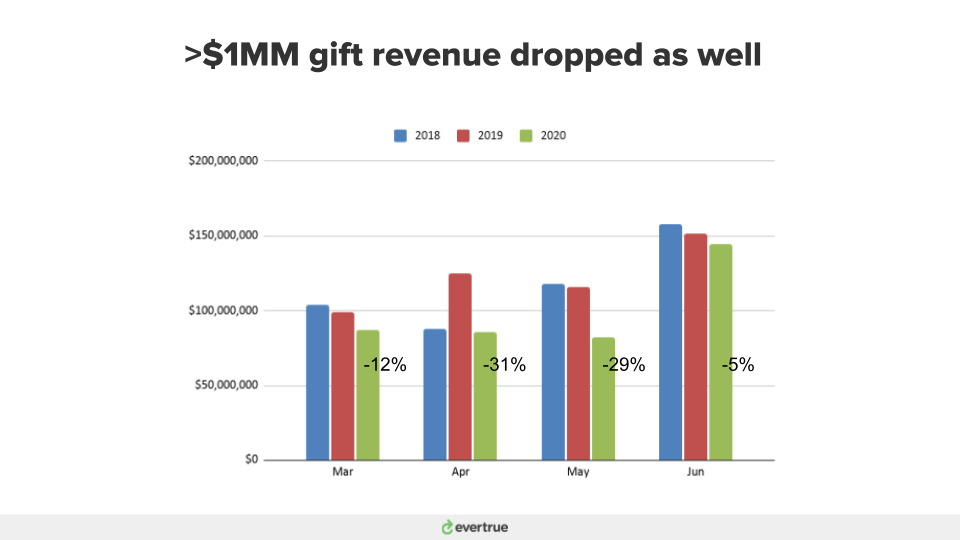
Advancement thought-leaders are uncertain
We’ve seen plenty of negative or mixed takes on the outlook for higher ed fundraising (here or here, for example) from pundits and have heard the difficulties of gift officers shifting to fundraising in a completely virtual world.
Yes, donor counts fell 10 percent from FY19 to FY20 (a massive year-over-year drop on top of an ongoing trend of decline).
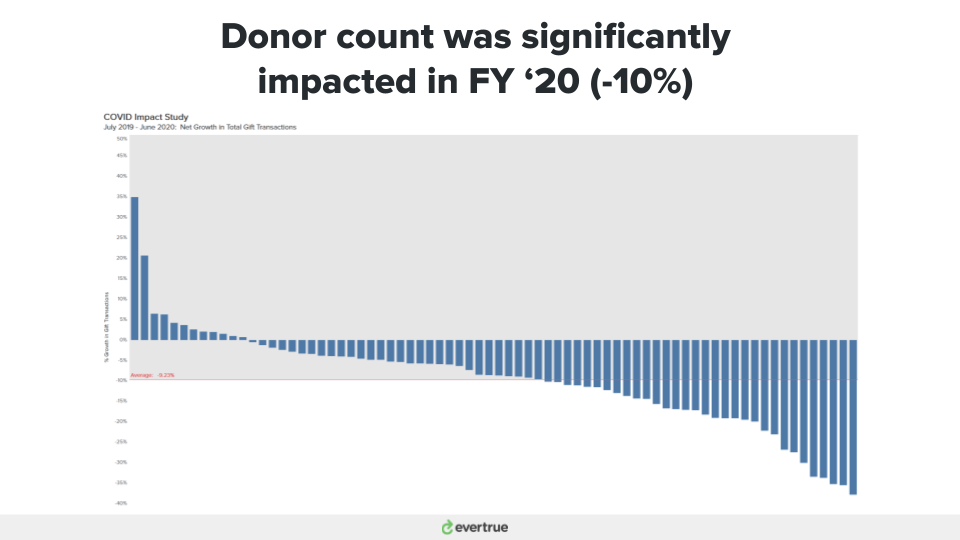
Yes, Zoom fatigue can be real.
Yes, Main Street is still hurting and we have record unemployment among the most vulnerable communities.
But there are three big reasons for optimism
Giving is making a comeback
After sharp declines March through May of 2020, donor counts started to rebound in the final quarter of the year.
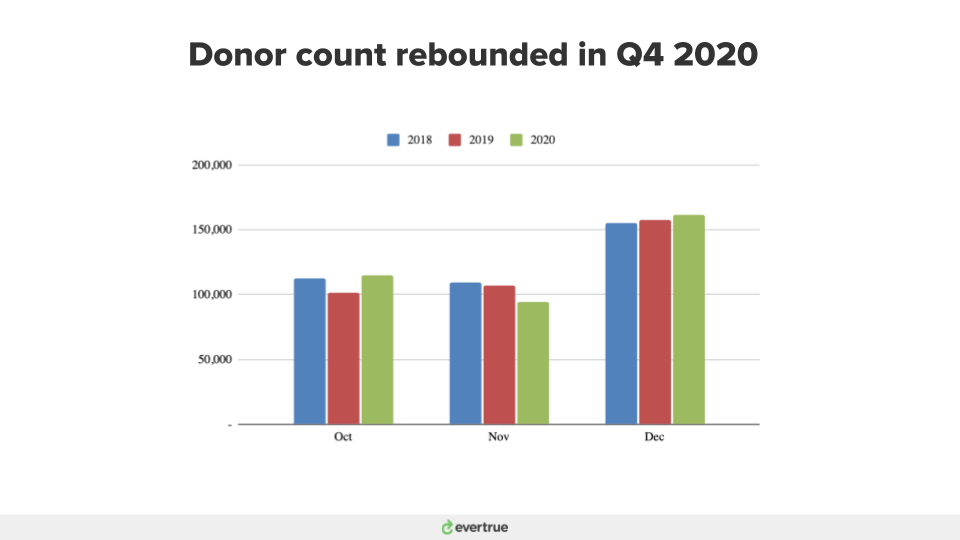
Revenue from gifts of less than $1 million also started to rebound and stabilize.
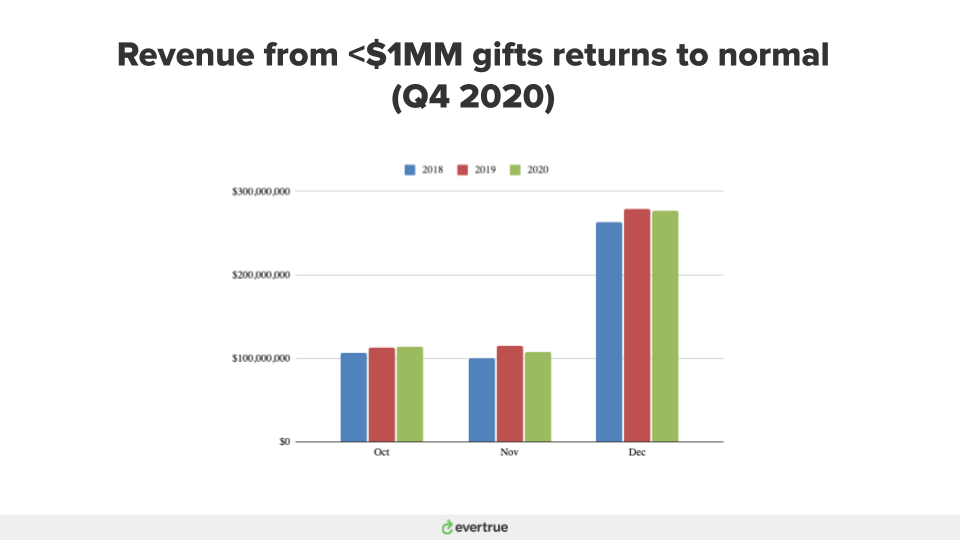
Including ALL gifts, the full 2020 calendar year outperformed 2019 by 1 percent. That’s not a huge growth margin, but it shows extraordinary resiliency. Despite everything that went wrong in 2020, higher ed fundraising still outpaced the prior calendar year.
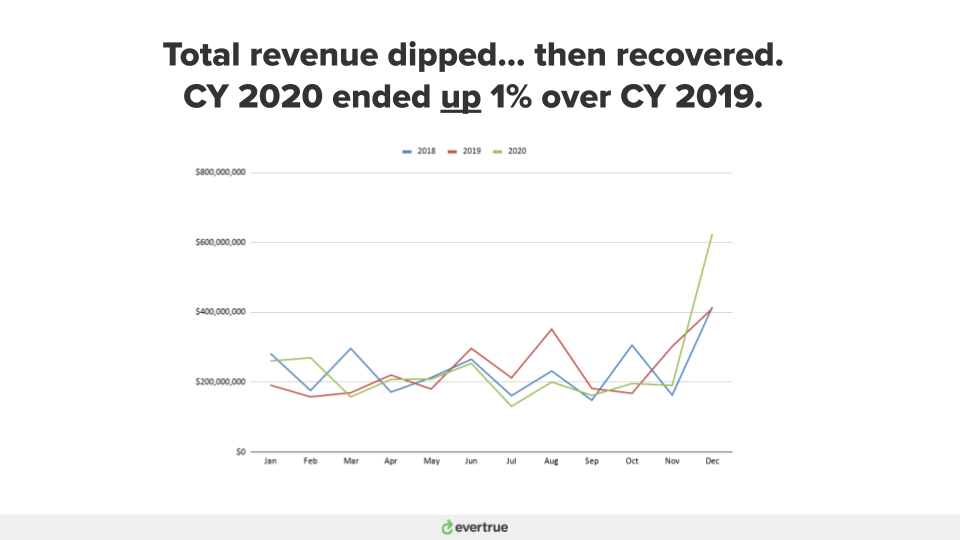
And gifts of all sizes came pouring in, with revenue making a huge spike in December.
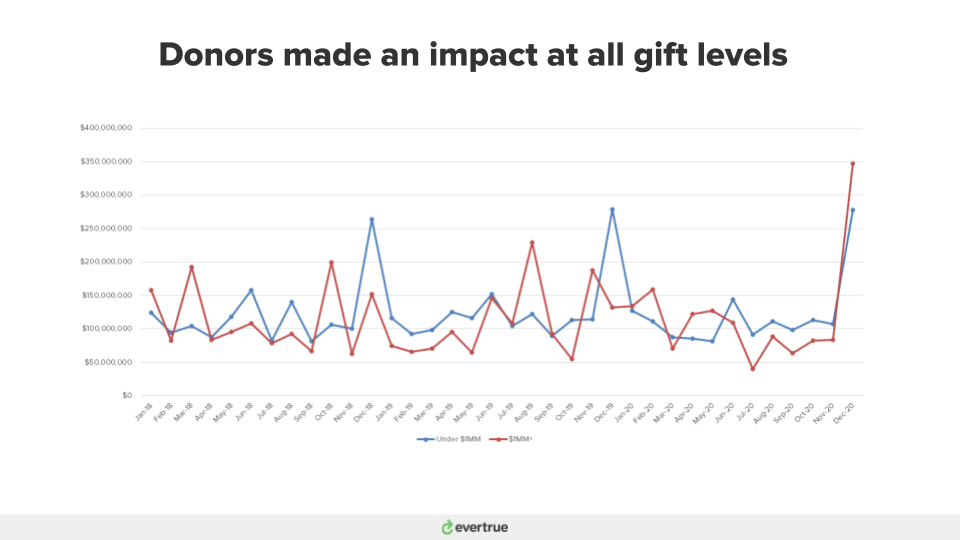
While there was a lull in giving at the start of the pandemic, educational donors are back giving in huge numbers, creating momentum for advancement teams to build on.
This giving reflects the enormous wealth creation and cash reserves created in the last year
There’s talk of a potential economic boom. “Economists surveyed by the Federal Reserve Bank of Philadelphia this month predicted that U.S. output will increase 4.5 percent this year, which would make it the best year since 1999. Some expect an even stronger bounce: Economists at Goldman Sachs forecast that the economy will grow 6.8 percent this year and that the unemployment rate will drop to 4.1 percent by December, a level that took eight years to achieve after the last recession.”
Increased savings, lower interest rates, and bailouts have left many U.S. consumers “flush with cash.” And we’ve seen surges in discretionary spending on boats, RVs, new lawns, swimming pools, and more.
Employment numbers are up for high-wage workers who earn $60k a year or more as “back-to-normal” indexes start to trend closer to pre-pandemic levels.
Donor/customer expectations have completely changed in the last 12 months
Shelter-in-place restrictions, the explosion of remote work, and customers turning to delivery services and online shopping have merged to reset consumer expectations around how they work, play, and spend.
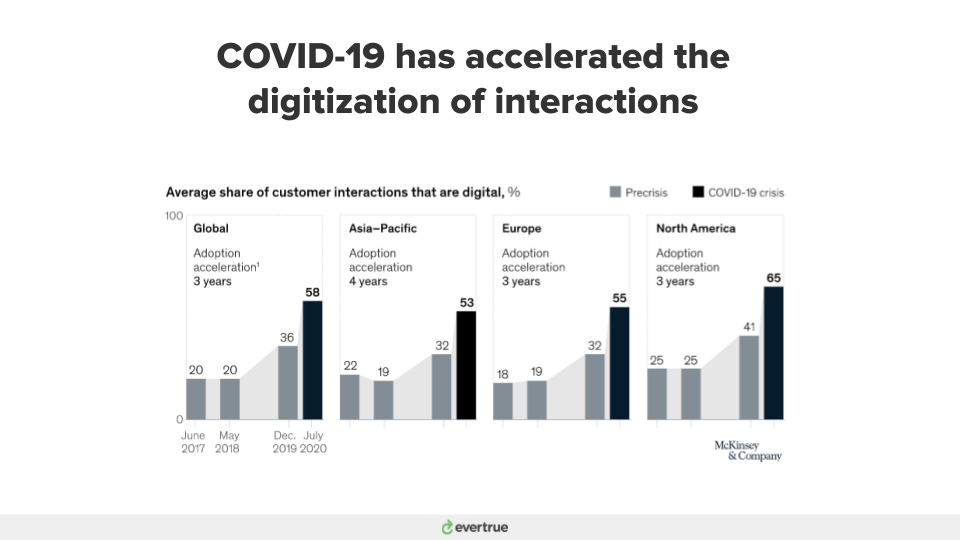
According to McKinsey & Company, the United States is now 3 years ahead of where it would be without the pandemic in shifting to digital interactions. And the things that are most likely to stay part of this “new normal” we’re in are changed customer expectations, remote work, and increased use of technology in all parts of life.
We cannot look to return to the way things were. We must embrace this shift to digital as a permanent cultural shift and adapt our organizations and fundraising strategy accordingly.
These institutions — among many others — have taken advantage of a shift in constituent expectations
The University of Arkansas for Medical Sciences doubled fundraiser portfolios
In the early days of the pandemic, the team at UAMS pivoted quickly. As they pulled fundraisers off the road, they also increased their portfolio sizes to 300 constituents and set aggressive activity goals. They made an assumption that with less time spent traveling from meeting to meeting, their team could reach more donors with stewardship and qualification calls. They were right. UAMS was one of only a handful of organizations that finished FY20 ahead of FY19 in both dollars and donors. (Listen to their story, which starts at 33:00)
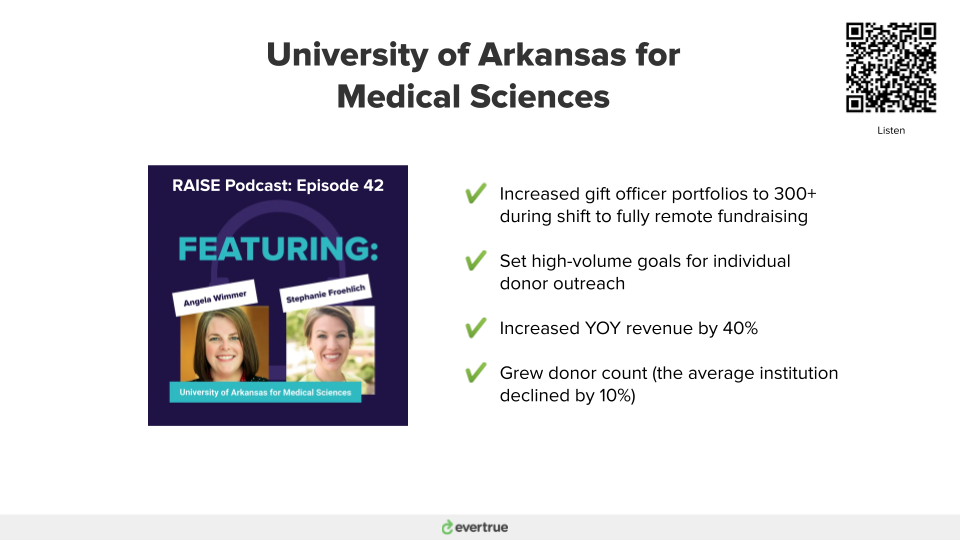
Launching Donor Experience Programs at Oregon State, Western Kentucky, Louisiana Tech, Boise State, Emory University, and elsewhere
The average advancement team manages assignments for only 2.8% of its constituents (source: EverTrue). And the larger the organization, the smaller that number tends to be.
Now, dozens of teams are looking beyond the very top of their donor pyramids and expanding coverage dramatically — in some cases, they’ve doubled managed prospects and assigned up to 10% of their donor base for ongoing, one-on-one outreach.
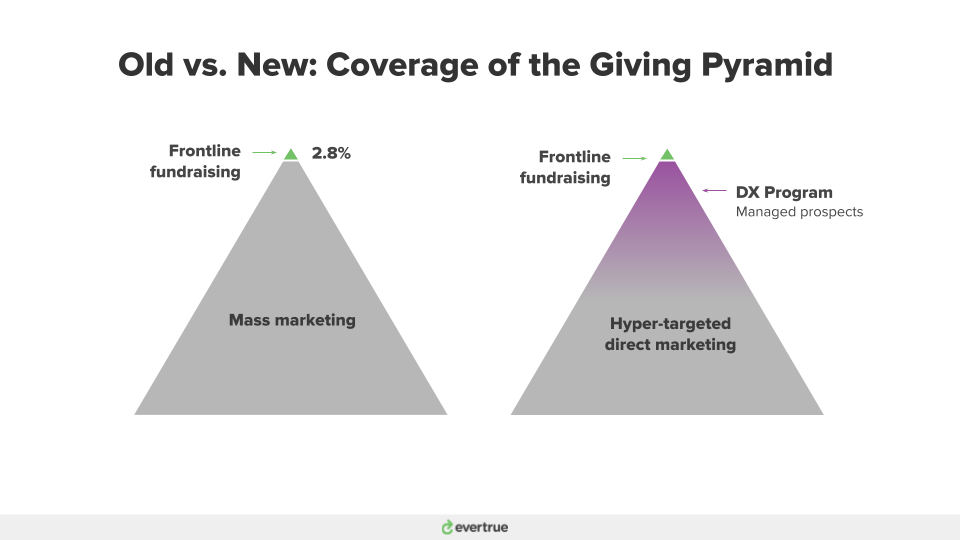
Teams are building 1,000+-person portfolios and assigning them to fully-digital, tech-enabled fundraisers. These are not static call sheets or mail merges. Rather, these fundraisers use EverTrue technology, insights, and coaching to create ongoing, authentic donor relationships. This is the first time most of these prospects have had a consistent, one-on-one relationship with a university fundraiser, and it’s paying huge dividends.
Like traditional gift officers, these Donor Experience Officers meet with potential donors, work with them to identify the intersections of that person’s interests and capacity, and design custom giving and stewardship plans for each.
But they use technology and repeatable outreach plans to do this at a far greater scale.
The University of Miami used Facebook to send 7,000 warm leads to gift officers
Since April of 2020, Miami’s digital engagement + philanthropic giving team has been looking at constituents’ Facebook engagement on specific posts, then following up directly with these potential donors.
By creating and sharing stories that tie back to the institutions giving priorities, then using EverTrue to find out who likes or comments on those posts, the Miami team is revealing potential donor interests. They then send each of these engaged prospects an email or a text with more information about that topic. And if the person responds, they refer them to a regional or major gift officer.
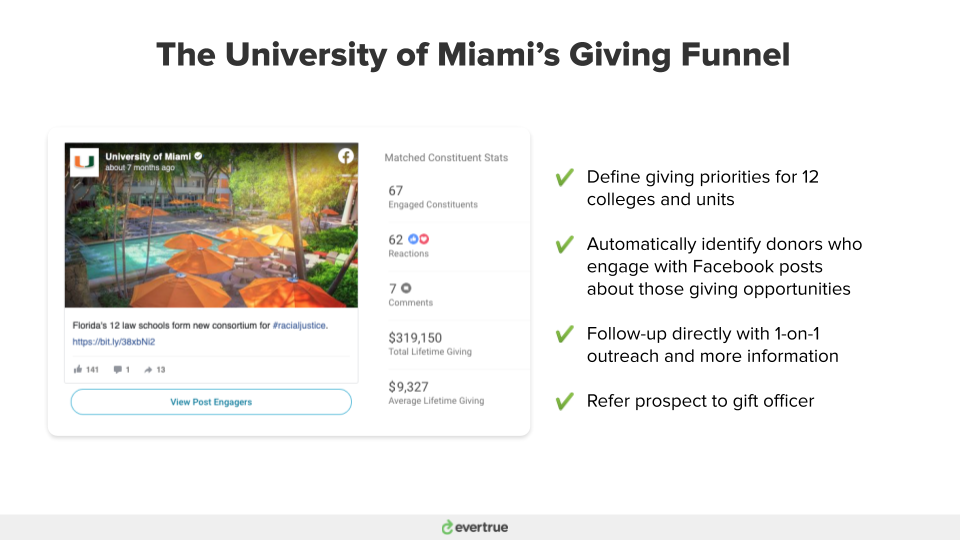
In less than 10 months, Miami has referred 7,000 newly identified prospects to gift officers, closed more than $600,000 in new gifts, and generated millions in potential pipeline.
George Washington shifts to a proactive approach to prospect discovery
In a similar vein, the GW prospect development team wanted to find quick ways to identify prospects who might be interested in three specific projects — renovating a dorm, building a new headquarters for Hillel, and supporting Colonial Athletics.
They used EverTrue to look for affluent donors who had given to these projects in the past, but at lower levels. They used Facebook insights to identify engaged, high-capacity donors and used EverTrue to quickly search past contact reports for people who had mentioned these projects.
In less than 8 months, they found 778 new major gift prospects, referred them to gift officers, and created $6 million in new proposals for these three hard-to-fund projects.
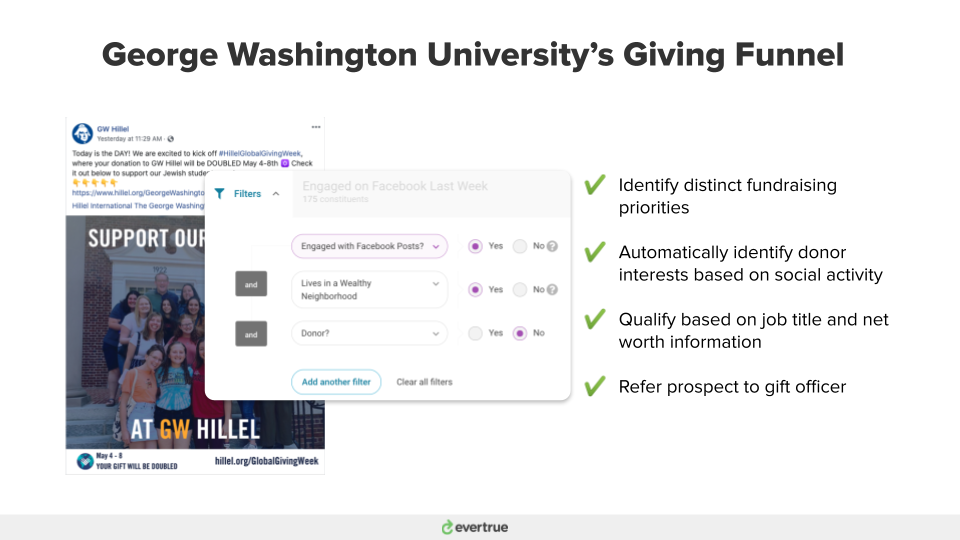
The University of Virginia turns virtual events into ongoing prospect engagement
As the UVA team pivoted away from in-person gatherings (they ended up hosting more than 600 virtual events in 2020), they used EverTrue’s Eventbrite integration to see which assigned prospects were registering.
This provided gift officers with an opportunity to reach out to donors in their portfolio. And it gave the research team new ways to identify the interests of high-potential prospects and update their ratings.
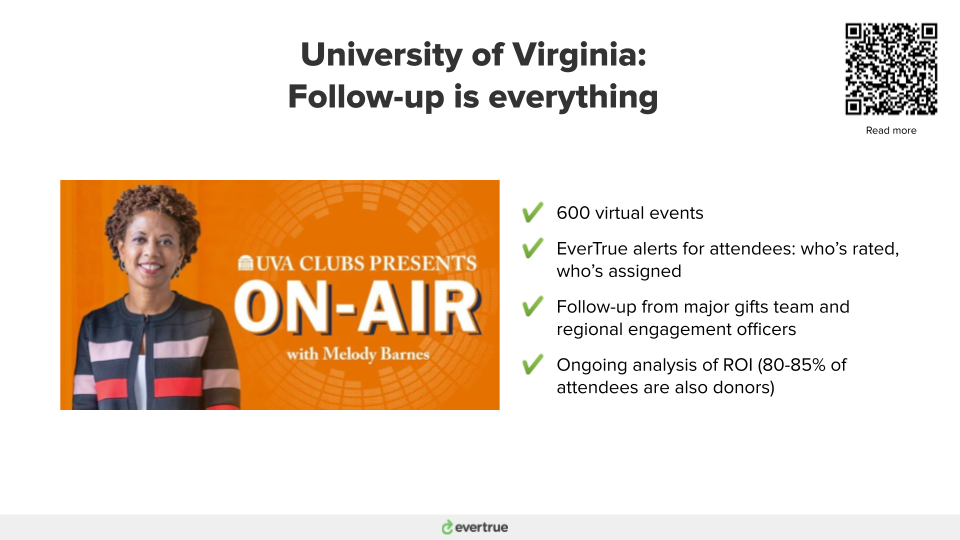
Here’s how advancement should adapt to take advantage of the “new normal”
Find and fix the broken links
Donors slip through the cracks all too often. Even those raising their hands — increasing their gift, engaging online, attending an event — are easy to overlook with a narrow focus on a handful of managed prospects.
So ask questions to find out where donors are falling off the map:
- What happens when someone engages online or attends an event? Is there follow-up?
- What happens when someone gives their first $1,000 gift? Or $10,000 gift? How are we stewarding these donors? Who’s responsible for follow-up?
- What is our overall donor retention rate? What is it for assigned prospects? What is it for unassigned, affluent prospects? Who is responsible for donor retention and, specifically, retention among the prospects with the most giving potential?
- How many people are managed by a gift officer? And how many of those have been contacted in the last 30, 90, and 365 days? (It’s likely that half of all your assigned prospects have not had a meaningful interaction in the last year.)
Use The Giving Funnel as a guide for managing advancement teams and creating a better journey for every donor.
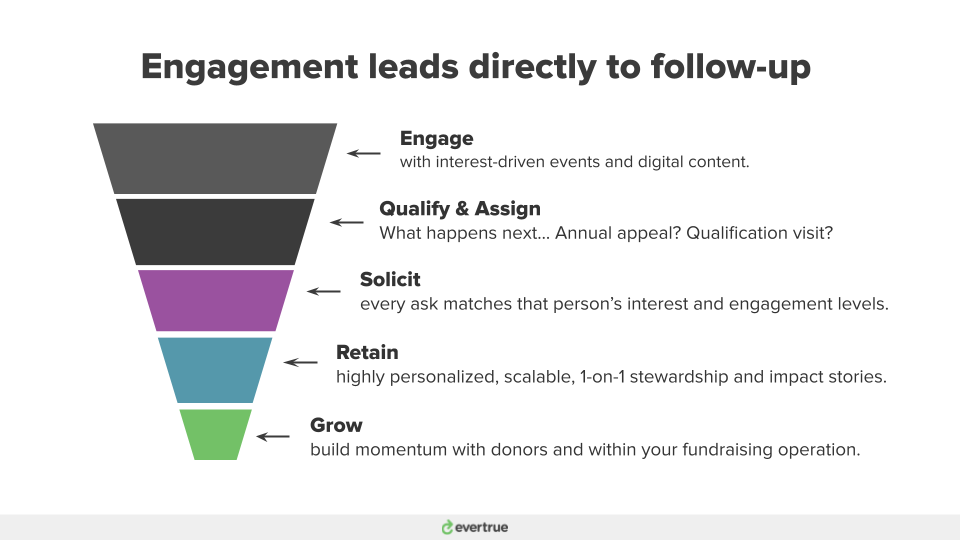
Create new roles and/or invest in technology to fill those gaps
There’s been an explosion in digital gift officer or Donor Experience Officer job postings because teams have realized there are so many people in their donor pool who should be assigned to a fundraiser.
In a fully digital world, content producers and video production teams aren’t a nice-to-have — they should be an integral part of every fundraising team.
And advancement should embrace the shift to remote work. It does not make sense anymore to have fundraisers fly across the country for a handful of visits twice a year. Rather, embedding fundraisers in key regions or looking beyond campus boundaries to hire the best remote employees is the right way to invest in hiring the best talent.
Teams also need technology to manage portfolios effortlessly, guide fundraising activity, unify engagement and wealth insights (shameless plug: this is why EverTrue exists). Having the right tech stack can fill gaps in headcount and make all team members more efficient and effective in their jobs.
Closing Thoughts
The biggest risk for fundraising in 2021 is to wait for things to go back to normal. Dozens of teams, large and small, have proven it’s possible to reach more donors, grow participation, and raise more despite the difficulties we’ve faced in the last 12 months.
We cannot apply the same tactics we did in 1999 or even 2019 in a world that’s this digital- and customer-centric. Advancement must continue to meaningfully engage more alumni, donors, and friends. Shops need to invest in technology that automates discovery, guides fundraising activity, and reveals donors’ interests and likelihood to give. And we must do whatever it takes to build personal relationships at scale. The future of our organizations depends on it.
Learn more about starting a Donor Experience Program with EverTrue.
